My main project for the past year has been working on a router table for my workshop. I don't have much time to do such work and things that take me well nigh forever would take someone who was relatively healthy a much, much shorter period of time. Also my general lack of skills also has something to do with this, and I took up making a router table as a skill teaching project for myself, and for that it was worthwhile even if the result was failure. Yes failure is always an option, and to combat it the idea with limited time is to set minor goals one can achieve in a short period of time. Bit by bit you move forward and at the end, if you played your cards right, you get something half-way useful.
Works, too!
So with no further fanfare, I'll start in on the thing, itself. No images are color corrected, btw, and the overhead lights don't give a visible yellow cast to things, but that is the way stuff in the distance gets without color correction. As an example the Incra tracks are an orange-gold color, not that weird yellow green.
This is the front end view, or the business end of things. My first decision a few years ago was to get a Veritas router table plate from Lee Valley Tools. I did that because I needed more work surface than your standard router table plate inset into a basic benchtop router table. My main point of dissatisfaction with a benchtop system is that it couldn't easily handle long pieces of material: they are great for smaller pieces, but the moment you get to 2x the width and active work portion of it, then you have a problem of actually getting a piece to stay flat to the table. What I wanted was a system that could deal with that problem by having a larger work surface, and a couple of inches here and there get doubled and the pieces get slightly bigger. Still the Veritas surface, even with a couple of inches extra, and lovely steel plate with which to use rare earth magnets to hold pieces down, needed some more space. To get more space means a longer dimension and then pick up the outfeed of longer pieces on something else.
That set up the parameters of being 34" high to use my workbench for outfeed, or manipulating larger pieces, and having a long dimension in which I could shift the fence system around and use that long dimension.
With the trim and such I have 48" of space for active use, and nearly 50" overall long. Two Incra T-Tracks with measuring tape pieces are on the major sides starting up at the miter slot and going to the end of the table. Internally there are some regular old aluminum T-Tracks that I got from Orange Aluminum.
Just under the top on the right side is a large drawer, which I'm using to hold all my 10" saw blades, and on each side is a small circular saw till for the 7 1/2" blades and one of my dado sets. Saw tills are tilt out, not pull out drawers.
The side exteriors have a 4" dust collection blast gate which is currently serviced by a Ridgid shop vac.
Now I have finally gotten the shop vac out of the way of the rest of the shop and centralized it. It is still easy to get out and use on its own when that is necessary, like for outdoor cleanout tasks. This met the requirement for having the shop vac stowed away to where it would have some standardized fittings to it, so that it would be easy to set up between multiple pieces of equipment. Any future machining pieces will have a 4" blast gate at the same height so that it can be easily attached to an ad hoc collection arrangement. I don't have the space necessary for a dedicated system, and this will do nicely until then. Also I can fit a portable dust collector I have to this system and take the vac out and put in a blast gate on its side, so that an actual 4" system can run through all of this. That portable system is loud and really needs to be run outdoors or with something between it and the shop environment.
All of this gets powered up from the rear with two inlets for 120v AC. Internally it is wired with 14 ga. Romex or equivalent and I ran it all through the 'can I power it all up and have no shorts?' phase of things while the top was still off.
Note that the entire affair is on casters with brakes on the corners and one in the center to support the bottom of the table so that it doesn't sag. This is a 'must have' necessity of any pieces of shop machine equipment from this point out until such time as living environment allows for a real shop to be put in place. With that said it is damn handy to be able to wheel heavy equipment around, and anything made out of nearly 5 sheets of 3/4" Baltic Birch plywood is to be considered a bit on the heavy side.
At the front again, the controls on the left are for one of the internal outlets (it is a duplex with the connector between outlets removed) and I have some LED strip lights to put in yet which will be run off the left side switch panel. Also on the left is the shop vac outlet switch. On the right is a standard 15A machine switch to run the Hitachi M12V2 router I picked up reconditioned from Big Sky Tool and they did a great job of getting the missing couple of pieces from my router that were supposed to be with it, and are one of the few places I could find that had such a router available at a price I could afford.
On the left and right are drawers running approx. 17" and 3" across, which is handy for putting small parts into. I have to see if tins from mints can fit in them as handy organizers. Right now they have my miscellaneous jig pieces, router bits and whatever else belongs with a router or jig work. The bottom drawer contains all the other router stuff and over-size bits, plus any of the excess stuff necessary for the table or making jigs. One of the great positives of having that huge expanse in the rear of the table is being able to put Incra jigs on it, and I'll be starting out with a very basic positioner type and seeing how well it can integrate with the Veritas fence.
One thing I've noticed is that the T-slot nuts I get from Lee Valley will work in either the Veritas or Incra equipment, but the Incra nuts only work with their own equipment. In theory each of these is using standardized slots, but in practice they are not using standardized fittings. Go figure.
One additional piece to add to this will be a car jack with one of those circular cups made of plastic. That I will put under the router and use for gross positioning of it, because trying to get the elevation right by lifting it by hand is a PITA. Time to repurpose one of the jacks I got for squaring up the refrigerator and freezer and pray I never need it for that again.
Also to be done are light door catches for the side doors, and for those small rare earth magnets should fit the bill. That front door was made out of ripped trim pieces... am I the only one to have thin ripped hardwood tend to warp? In any event, all of that was given a temporary glue-up, then glued to plexiglass and the thing warped to the slight warping of the trim pieces. I had always thought I would use a hasp or small cylinder lock on the door, but it would be unsightly if the top and bottom were pulling away. The answer is to 1/2" cylinder x 1/2" long rare earth magnets (with something like 35 lb. pull apiece) on the interior frame corners and then two 3/4" nominal square pieces of 28 ga. galvanized sheet steel glued to where they can't be seen from the front. Works like a charm!
Other than that the basics are 5 sheets of 24"x48" Baltic Birch ply from Rockler, plus a couple of sheets of 1/4" ply from them, and then Padauk cut to size, ripped and mitered at the corner (and the fit is not so hot, but the benefit of not gluing the in is that I can always replace them), plus some 3/4" square nominal Padauk for the corners (dowel top and bottom), and 1/4" thin rip 15/16" Padauk for the lower trim. Mostly that was done for looks, but also it hands me a clamping surface on the top which is needed for jigs.
Originally I had ideas of making the entire thing knockdown and if I sacrifice the lower trim, it still can be. The top, however, is totally removable and separate from the router plate support system which has all the drawers in the front in it. This means that if the top gets totally ruined, it can be replaced completely as nothing is attached to it. At one point I had ideas of putting a set of heavy duty chest hinges in the back which would allow the entire top to swivel up like a car hood... but the thing was already complex enough that I didn't want to do that once I realized that the tills would have to go or be seriously downsized or a major tray put in on the top which would replace the drawer and tills.
Hardware I got from all over with a lot coming from D. Lawless Hardware, but other pieces are coming from Lee Valley and Amazon. And about a zillion other places I've scrounged parts from... I have a long list of hardware suppliers from the absolutely modern to the 'if it has to be stock period Victorian, we got the knob for you!' sort of place. Mostly I went cheap on the knobs and handles, but the concealed Soss hinges are a nice touch for the doors even if they are a PITA to install.
I make no money, get no benefit and no perks from any place I link to – I am just a customer. YMMV.
Basically the table is in the 98 to 99% stage, lacking the LEDs (which I need to splice some wires together to let them fit) and magnet catches.
I finished it with walnut oil (1:4 limonene for a couple of coats, then progressive 1:3, 1:2 and 1:1) and have used an equal portion by volume of beeswax and carnauba wax (90/10), linseed oil (not boiled) with just a bit of leftover walnut and tung, plus limonene. If you don't need the wax finish all that quickly, just put the limonene (or turpentine if you use that) together with the beeswax in a sealed glass jar (like a mason jar) and set it on shelf that gets sunlight for a week, and it should be dissolved. I used wax flakes and did a basic 'shake the hell out of it' dissolving, left it sealed in a jar in a warm room for a few weeks and then finally had to use a double boiler, and to do the final dissolving and add the oils. A fun note is that by basic volume you get a soft wax suitable for rubbing on surfaces, if you do it by weight, you get a hard wax suitable for your tools. Too much air in wax flakes to do it properly by volume, but it makes for a great wax to rub on, like I did with the surface of the router table. I have one batch of wax with just linseed oil and a bit of lavender oil (like a quarter teaspoon to a cup of linseed oil), and need to find someone who has lost their sense of smell to pawn it off on as a furniture wax.
The limonene I got as 'technical grade' from someplace on Ebay, and it is derived from oranges. My prior stuff was from limes. When I use the waxes as a finish it smells like I've just made some tea... and when I applied the walnut with limonene, it smells like a salad dressing. Limonene is your turpentine replacement and it is used in shampoos, cosmetics, and as a sort of universal solvent for all things sticky. Use just as turpentine, and while it is nice you still need heavy ventilation...non-toxic doesn't mean it won't give you a headache.
The trim is done in super blonde shellac that I got from Shellac Shack and with just one 2# cut coating using a French padding technique, and it came out just fine. Padauk has a lot of natural oil in it and I really can't see wanting to try and mess up the character of the wood by an oil finish. Only two coats and then a bit of final rubbing out to cut the luster of the shellac and I have zero complaints on that. A router table finished that you can eat off of if you had to, but I wouldn't recommend it.
Currently doing some of the minor tasks that got put aside for this.
Nearly done with a Oneway grinding/sharpening/honing jig for my 6" DeWalt bench grinder. Simple compared to a router table.
Next up will probably be a toolchest/workstation/shelving unit for all the major tools that need a real home (like my bench planes and hand saws) and it must conform to the 34" height requirement.
A real benchtop for a set of rivet shelves/workstation has to be done, as well, and that will probably be a rip and glue up sort of deal, with lots of planing and sanding at the end of it. I got in a couple of small 8/4 Maple slabs to cut the ends for such a thing, but the ripping of other woods will be the major chore.
General tool storage is a big headache and that really should be in boxes, so that is on the agenda at some point. Custom boxes.
A miter saw station (mobile) to conform to 34" standard and dust collection standard.
I would love to get the contractor table saw down to 34", but see no way to do that with its current stand. Although I tend to use that outdoors, if it had a proper dust collection system for all the stuff that doesn't go down its exhaust, that would be splendid... no way to cut the noise, though.
Then on the household end a Queen size loft bed would be great to get floor space back in an upper room, but that is looking to be a 'purchase' option rather than hand-made custom option, save for creating a lower interior sewing and computer space under the bed.
A gun display case, not that I have that much to display, but it's the principle of the thing.
All of this should go so much faster with a router table.
In theory, at least.
Practice is something else, again.




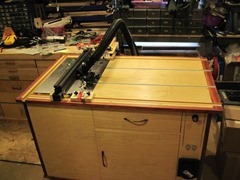



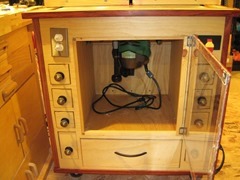
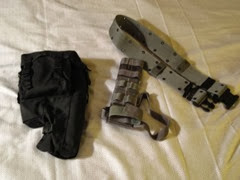
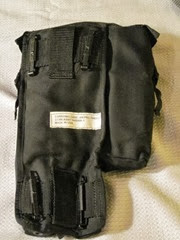

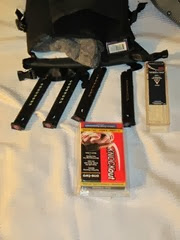
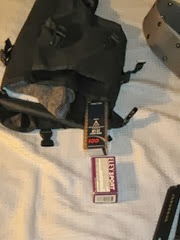


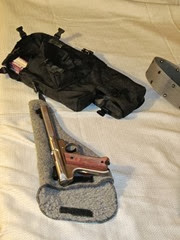




 Supporting Friends and Allies
Supporting Friends and Allies








